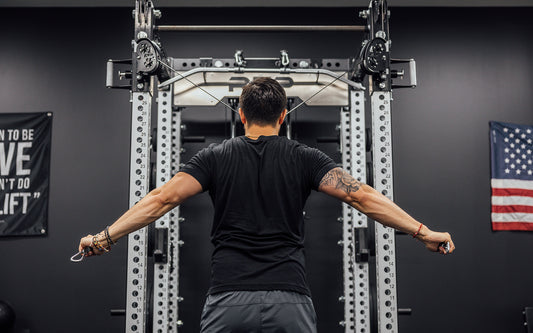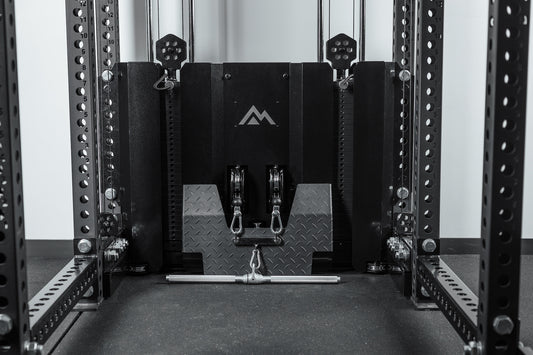
If you’ve ever been pinned in a bench press or tacoed by a squat, you know it firsthand: There’s not a lot more terrifying than getting trapped under a heavy barbell.
If you haven’t, well, take our word for it and don’t let it happen to you.
When lifting at home alone, it’s especially important to create a safe gym environment. A critical component of that is to make sure your power rack has safeties. Safeties are horizontal pins or straps that connect to your rack to catch the barbell if you miss a lift.
All REP power racks come with safeties, but there are three different kinds to choose between: Pin-Pipe Safeties, Flip-Down Safeties, and Strap Safeties.
Pin-Pipe Safeties

Pin-Pipe Safeties are simple, basic safeties. They come in different lengths to fit different rack sizes. These traditional safeties are 11-gauge, 2” diameter steel pipes that slide into the rack uprights like a J-cup. If you want standard safeties with no sharp edges that work with any rack, the pin-pipes are a good bet.
Pin-Pipe Safeties are compatible with 1000, 4000, and 5000 Series power racks, but the 1000 Series version is slightly different. The 1000 Series pins are steel with a chrome pin finish and no outer layer on the pipes. The 4000 and 5000 Series Pin-Pipe Safeties are made from steel with a chrome pin finish and a matte black pipe finish.
Flip-Down Safeties

Flip-Down Safeties slide into the uprights like a J-cup. Lock them into place with a clevis pin and flip them down into place. Flip-downs work with 4000, 5000, and 1000 Series power racks.
In addition to saving your butt on a bad lift, you can use them to pull from (they can handle 1,000lbs for the 4000 and 5000 Series racks and 700lbs for the 1000 Series). And they have 1" holes on the side to attach to some 5000 Series attachments (like a Leg Roller or Utility Horn). A cool bonus is even the 1000 Series Flip-Down Safeties are compatible with some 5000 Series attachments, opening up even more possibilities for your 1000 Series rack.
For the 4000/5000 Series, plastic liners inside and out protect your equipment, and additional liners along the C-cup brackets protect the uprights. The 1000 Series features a protective liner on top of the safeties.
If you want safeties that are also super versatile, these are your guys.
Strap Safeties

Upgrade to Strap Safeties, which are reinforced nylon straps, secured to brackets with heavy-duty bolts. Lifters like these because they’re quieter than steel safeties – virtually noiseless. They’re also gentler on your barbell and uniquely adjustable, because you can mount the front and back ends at different heights. This is nice for bailing out of a lift. For example, if you fail a squat, with offset safeties, the bar can roll away from your back and make it easier to get out from under the load.
These are compatible with the 4000, 5000, and 1000 Series racks, and they come in various different lengths.
Other Ways to Stay Safe in the Gym

Safeties can only protect you so far. Even with safeties, you need to practice smart lifting to steer clear of injury. Here are some other ways to keep safe in the gym:
Warm up. Don’t just climb under a heavy load without preparing your body. Do some mobility drills, active stretching (that’s movement + stretching, not just sitting into a static stretch), and light movement to get the blood pumping, and then incrementally add resistance until you reach your working weight.
Practice good form. Form is more important than the weight on the bar. Don’t lift for your ego or the 'gram. It doesn’t matter how much weight you can lift if you can’t lift it with correct form and end up getting hurt. If you aren’t sure how to perform an exercise properly, ask for help or hire a trainer.

Ask for a spot. Safeties are great if you are lifting alone, but if you are planning on maxing out, it’s better yet to lift with safeties and a human spotter. They can help watch your form, too (and vouch for your PR if your camera fails).
Clean up after yourself. Clean the equipment before and after you lift, even if you don’t share it with others. Take care of your equipment to keep it working properly and to avoid a build up of dust, chalk, and other grime. Put your weights and gear away so you don’t trip on it.
Take a rest. Rest days are important for muscle repair – and they can help reduce the risk of overuse injury.
Know the rules. Check out this story: “11 Rules of Barbell Etiquette.”

